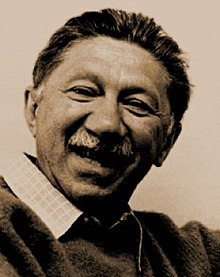 Abraham Harold Maslow
Abraham Harold Maslow (April 1, 1908 – June 8, 1970) was an
American psychologist who was best known for creating
Maslow's hierarchy of needs, a theory of self-actualization.
[2] Maslow was a
psychology professor at
Brandeis University,
Brooklyn College,
New School for Social Research and
Columbia University.
He stressed the importance of focusing on the positive qualities in
people, as opposed to treating them as a "bag of symptoms."
[3]
Abraham Maslow Quotes
"For any man of good will, there is work to be done here, effective,
virtuous, satisfying work which can give rich meaning to one's own life
and to others"
Metamotivation
Maslow used the term
metamotivation
to describe self actualized people who are driven by innate forces
beyond their basic needs, so that they may explore and reach their full
human potential.
[37]
B-values
In studying accounts of peak experiences, Maslow identified a manner
of thought he called "Being-cognition" (or "B-cognition", which is
holistic and accepting, as opposed to the evaluative
"Deficiency-cognition" or "D-cognition") and values he called
"Being-values".
[38] He listed the B-values as:
- Wholeness (unity; integration; tendency to one-ness;
interconnectedness; simplicity; organization; structure;
dichotomy-transcendence; order);
- Perfection (necessity; just-right-ness; just-so-ness; inevitability; suitability; justice; completeness; "oughtness");
- Completion (ending; finality; justice; "it's finished"; fulfillment; finis and telos; destiny; fate);
- Justice (fairness; orderliness; lawfulness; "oughtness");
- Aliveness (process; non-deadness; spontaneity; self-regulation; full-functioning);
- Richness (differentiation, complexity; intricacy);
- Simplicity (honesty; nakedness; essentiality; abstract, essential, skeletal structure);
- Beauty (rightness; form; aliveness; simplicity; richness; wholeness; perfection; completion; uniqueness; honesty);
- Goodness (rightness; desirability; oughtness; justice; benevolence; honesty);
- Uniqueness (idiosyncrasy; individuality; non-comparability; novelty);
- Effortlessness (ease; lack of strain, striving or difficulty; grace; perfect, beautiful functioning);
- Playfulness (fun; joy; amusement; gaiety; humor; exuberance; effortlessness);
- Truth (honesty; reality; nakedness; simplicity; richness; oughtness;
beauty; pure, clean and unadulterated; completeness; essentiality).
- Self-sufficiency (autonomy; independence;
not-needing-other-than-itself-in-order-to-be-itself; self-determining;
environment-transcendence; separateness; living by its own laws).
Hierarchy of Needs
A visual aid was created to explain his theory, which was called the
Hierarchy of Needs, is a pyramid depicting the levels of human needs,
psychological and physical. When a human being ascends the steps of the
pyramid he reaches self-actualization.
- At the bottom of the pyramid are the “Basic needs or Physiological needs” of a human being: food, water, sleep and sex.
- The next level is “Safety Needs: Security, Order, and Stability.”
These two steps are important to the physical survival of the person.
Once individuals have basic nutrition, shelter and safety, they attempt
to accomplish more.
- The third level of need is “Love and Belonging,” which are
psychological needs; when individuals have taken care of themselves
physically, they are ready to share themselves with others, such as with
family and friends.
- The fourth level is achieved when individuals feel comfortable with
what they have accomplished. This is the “Esteem” level, the need to be
competent and recognized, such as through status and level of success.
- Then there is the “Cognitive” level, where individuals intellectually stimulate themselves and explore.
- After that is the “Aesthetic” level, which is the need for harmony, order and beauty.[32]
- At the top of the pyramid, “Need for Self-actualization,” occurs
when individuals reach a state of harmony and understanding because they
have achieved their full potential.[33]
Once a person has reached the self-actualization state they focus on
themselves and try to build their own image. They may look at this in
terms of feelings such as self-confidence or by accomplishing a set
goal.[34]
The first four levels are known as '
Deficit needs' or '
D-needs'.
This means that if you don't have enough of one of those 4 needs,
you'll have the feeling to get it. But when you do get them then you
feel content. These needs alone are not motivating.
[35]
Maslow wrote that there are certain conditions that must be fulfilled
in order for the basic needs to be satisfied. For example, freedom of
speech, freedom to express oneself, and freedom to seek new information
[36] are a few of the prerequisites. Any blockages of these freedoms could prevent the satisfaction of the basic needs.
















